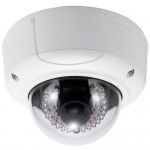I n the past setting up a security camera required the use of several pieces of equipment to operate. Perhaps, you even had to run wire to connect all the components. It was often a real nightmare. With the introduction of the IP camera those days are gone.
n the past setting up a security camera required the use of several pieces of equipment to operate. Perhaps, you even had to run wire to connect all the components. It was often a real nightmare. With the introduction of the IP camera those days are gone.
An IP camera, also known as an Internet protocol camera, allows for remote viewing from a static IP address or a dynamic domain name server. When the camera is active, the camera captures the image and adjusts it for exposure, white balance and image sharpness. Then the image passes it through an optical filter. The optical filters remove any infrared light allowing the system to display correct colors. Now the image is converted into electrical signals. Then the electrical signals are compressed within the camera and sent over the Internet network to other devices on the network. The camera works as a web server that can communicate directly with other devices on the network. It is possible to view images from the IP camera from any place that has high-speed Internet access is available. Some IP cameras are even viewable on smartphones and PDAs.
The user must consider three factors when installing an IP camera, also known as a network camera. They are the amount of storage space, the image quality and the amount of lighting. When images are sent from the camera to the storage device, they take up a lot of storage room. For the best image quality look for a camera that will compress the images using either JPEG or MPEG technology. If the user buys a camera with video conferencing video, then they will be unhappy with the image quality of fast moving objects.
JPEG and MPEG technology takes up a lot of bandwidth. Therefore, it is necessary for the user to consider how much memory they want the system to use. A common practice is to have the system automatically delete the older images as new images are captured.
The image quality captured by an IP camera is a trade-off situation. Image quality is determined by the amount of pixels on the camera and the size of the sensor that converts the lightwaves to electrical signals. When image rate is high, then the camera’s frames per second rate drops. This is a trade-off situation that the buyer needs to carefully consider.
The third factor is the amount of available light for the camera to use. The camera will deliver better images with more light. Generally, an IP camera requires a minimum of 200 lux of light to deliver good image quality. When there is not enough light, the images will appear blurry. Another problem with lighting for these cameras exists when the camera is pointed toward a light source. The images caught will have large spots that appear washed out because the camera cannot account for the excess light.
These cameras can be controlled from a remote location. They can be panned to see left and right to better see the action. They can be tilted up and down to see an object better. They can also be zoomed to focus more directly on the action. When using an IP camera, it is very easy to follow a person through a secure location.
These cameras have many uses. They are great for protecting vacation homes since the images can be seen anywhere that there is high-speed Internet access. They are useful in the workplace especially in secure locations for identifying people that need in that location. The camera can put a time stamp on the images in situations where the time something occurs is important. They can be used to monitor workmen in remote locations.
